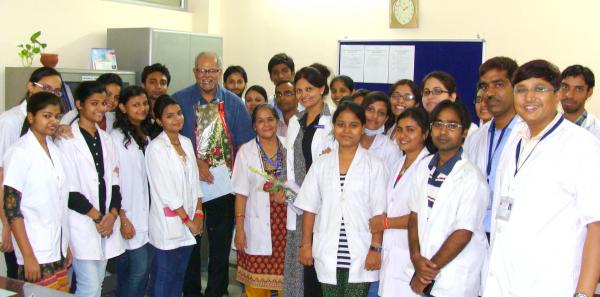 Scientific research is one of the most exciting and rewarding of occupations...........Frederick Sanger
Scientific research is one of the most exciting and rewarding of occupations...........Frederick Sanger
Arsenic – The Slow Poison Threatening Bihar
Our continued research on arsenic contaminated aquifers of fluvial plains in the state of Bihar, India, may be regarded as an extension of similar investigations being carried out in the adjacent eastern Bengal basin. Bihar lies in a “foredeep” bound by Himalayan orogeny in the north and geologically complex peninsular Plateau in the south. Its geographical extent is 240 20’N to 270 31’15”N, and 830 19’50” E to 880 17’40”E longitudes. Bihar is the second most densely populated state of India having 82,878,769 persons, 89.53% of which is rural population. The rural per capita income of this economically backward state is less than Rs. 5000 [approx. £ 60] per annum, and it is largely sustained by its agriculture-driven economy. The state of Bihar primarily derives its resources from the rich fertile soils and surface and ground water resources It also suffers from floods and droughts almost alternately, and to cope with increasing agricultural targets and demand for potable water, thousands of tube wells have been constructed to utilize the vast, deeper channels of ground water.Since 2004, we have tested over 28,000 public tube wells, and over 2000 private [domestic] bore wells, 25% to 30% of which spew arsenic contaminated waters of 50 ppb. and above. To be noted is the fact that this preliminary work area was demarcated as a 5km. wide belt along the banks of river Ganga in the 4 districts of Patna, Bhojpur, Vaishali and Bhagalpur. Random investigations have revealed high contamination levels in the entire tract of alluvium drained by the Ganga and its tributaries, thereby enlarging the affected area to the entire flood plain of Bihar. About 89% of entire Bihar is covered with Quaternary fluvial deposits that are more than 300 meter thick except in the southern boundary of Pre Cambrian rocks, and holds potential alluvial aquifers many of which have high arsenic levels. In the Holocene period marine transgressions were responsible for aggregation and sedimentation of new alluvium. This area is underlain by multi-layer sequence of sand [aquifer] alternating with aquitard like sandy-clay and clay down to depth of 300 meters. There is a proven correlation between high iron and high arsenic concentrations. In Bihar, majority of the arsenic hotspots found to be distributed in HCO3 – dominated ground water facies. Contrary to our preliminary assessment that arsenic hotspots clustered along the banks of the master stream, Ganga, the interfluvial terrain and Himalayan foothills in north Bihar also tested positive for arsenic contaminated ground waters, the latest concentrations being detected in Darbahanga-Purnea interfluves and the Kishanganj- Supaul Terai belts.Typical characteristics of the occurrences of arsenic contaminated aquifers worldwide are revealed here too. Wide spatio-temporal variations and higher contamination levels in aquifers most exploited [generally being shallow aquifers of upto 100 feet deep] are common. However, in western district of Bhojpur, contamination levels increase with depth and away from the banks of the Ganga – this peculiarity requiring further geochemical investigations.One of the major pointers to increasing arsenic levels in shallow aquifers has been their usage as perennial sources of irrigation water. I have tested the soils, edible agricultural plants ranging from rice to vegetables, and irrigation water for arsenic uptake, and obtained positive results of over 50 ppb in all three sample categories. In contrast to the Bengal contaminations where symptoms of arsenic poisoning are highly visible, in Bihar, visible symptoms are recent phenomena, with a lesser number of full blown cases of arsenicosis. Hence, opportunities still exist to contain the effects of these contaminations, and also to look into innovative, sustainable mitigation techniques
Microbes Working as Biofertilizers
We have isolated more then hundred microbes from soil of Bihar under the DBT project [MBCN of Bihar].Three of them have been identified as microbes with biofertilzer capabilities.These microbes have been tested individually and in different contortia on Maize for their biofertilizer potential.Encouraging results have been recorded both on vegetative growth and reproductive growth.The PI of the research project ,Dr.Ashok Ghosh plans to get these microbes patented soon.
Synthesis of Silver Nanoparticle by Bacteria
Recently my Research Group has identified Bacteria capable of synthesizing Silver Nanoparticle by Bacteria - Bacillus cereus.The strain has been preserved at IMTECH,Chandigarh.The silver nanoparticles have been already characterized .Furthermore Cadmium and Lead nanoparticles also have been synthesized and characterized in our lab..The news about the breakthrough was published on front page of Hindustan Times on 16th March,2008.The findings were presented at International conference of Nano science held in Boston in the month of June,2008. |
